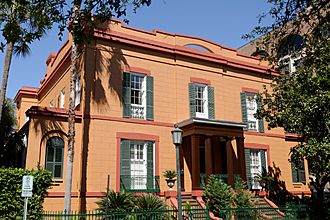Sorrel–Weed House facts for kids
Quick facts for kids Sorrel–Weed House |
|
|---|---|
 |
|
| Former names | Sorrel House |
| General information | |
| Location | 6 West Harris Street, Madison Square, Savannah, Georgia |
| Coordinates | 32°04′27″N 81°05′39″W / 32.07412°N 81.09405°W |
| Construction started | 1835 |
| Completed | 1840 |
| Design and construction | |
| Architect | Charles B. Cluskey |
The Sorrel–Weed House is a famous historic home and museum in Savannah, Georgia. It is located at 6 West Harris Street on Madison Square. The house is a beautiful example of Greek Revival and Regency architecture. These styles were popular in the 1800s and were inspired by ancient Greek and Roman buildings.
In 1954, it became one of the first two houses in Georgia to be named a State Landmark. With 16,000 square feet of space, it is also one of the largest homes in the city. Today, the Sorrel-Weed House is a museum. You can take historical tours during the day and even go on ghost tours at night.
The house was the childhood home of Moxley Sorrel. He grew up to be a Brigadier General for the Confederate States of America during the American Civil War. A famous general, Robert E. Lee, was a friend of the Sorrel family and visited the house several times.
Contents
History of the House
The Sorrel-Weed House was designed by a well-known architect named Charles B. Cluskey. He also designed the old Governor's Mansion in Milledgeville, Georgia. The house was built between 1835 and 1840 for Francis Sorrel, a rich merchant in Savannah.
The People Who Lived There
Francis Sorrel was a wealthy man who made his money in the shipping business. During this time in history, it was common for wealthy white families in the South to own enslaved people. Records show that Sorrel enslaved several people throughout his life. The lives of enslaved people were extremely difficult and full of hardship.
In 1862, a businessman named Henry D. Weed bought the house. It stayed in the Weed family for over 50 years. Later, in 1941, the Cohen family bought the home and lived there for more than 50 years. They even opened a popular women's clothing store called Lady Jane in a new part of the house. The store closed in 1991, and the house was sold again in 1996.
A Famous Movie Location
Have you ever seen the movie Forrest Gump? The very first scene of the movie, where a feather floats down from the sky, was filmed from the roof of the Sorrel-Weed House. The camera shows the view of Madison Square from the top of the house. Because of this, the house is a popular spot for tourists to visit.
A Haunted Reputation
The Sorrel–Weed House is famous for being one of the most haunted places in Savannah. There are many spooky stories about the house. One of the most famous legends is about an enslaved woman named Molly. However, historical records show no one named Molly ever lived there. While this story is not true, it reminds us of the terrible hardships that enslaved people faced.
Because of its spooky reputation, the house has been featured on many television shows. These include Ghost Hunters, Ghost Adventures, and "The Most Terrifying Places in America." Many people visit the house hoping to experience something paranormal.
Architectural Design
The Sorrel-Weed House is known for its amazing architecture. It mixes the grand style of Greek Revival with the elegant style of English Regency.
One special feature is the entryway, or foyer. The architect, Charles Cluskey, used two large columns to divide the space. This was a clever way to create a small area where guests would wait to be greeted before entering the main part of the home.
Another interesting feature is the main staircase. It goes up to a landing in the middle, then splits into two smaller staircases that go to the second floor. This design is similar to another famous house in Savannah, the Owens-Thomas House.
See also


